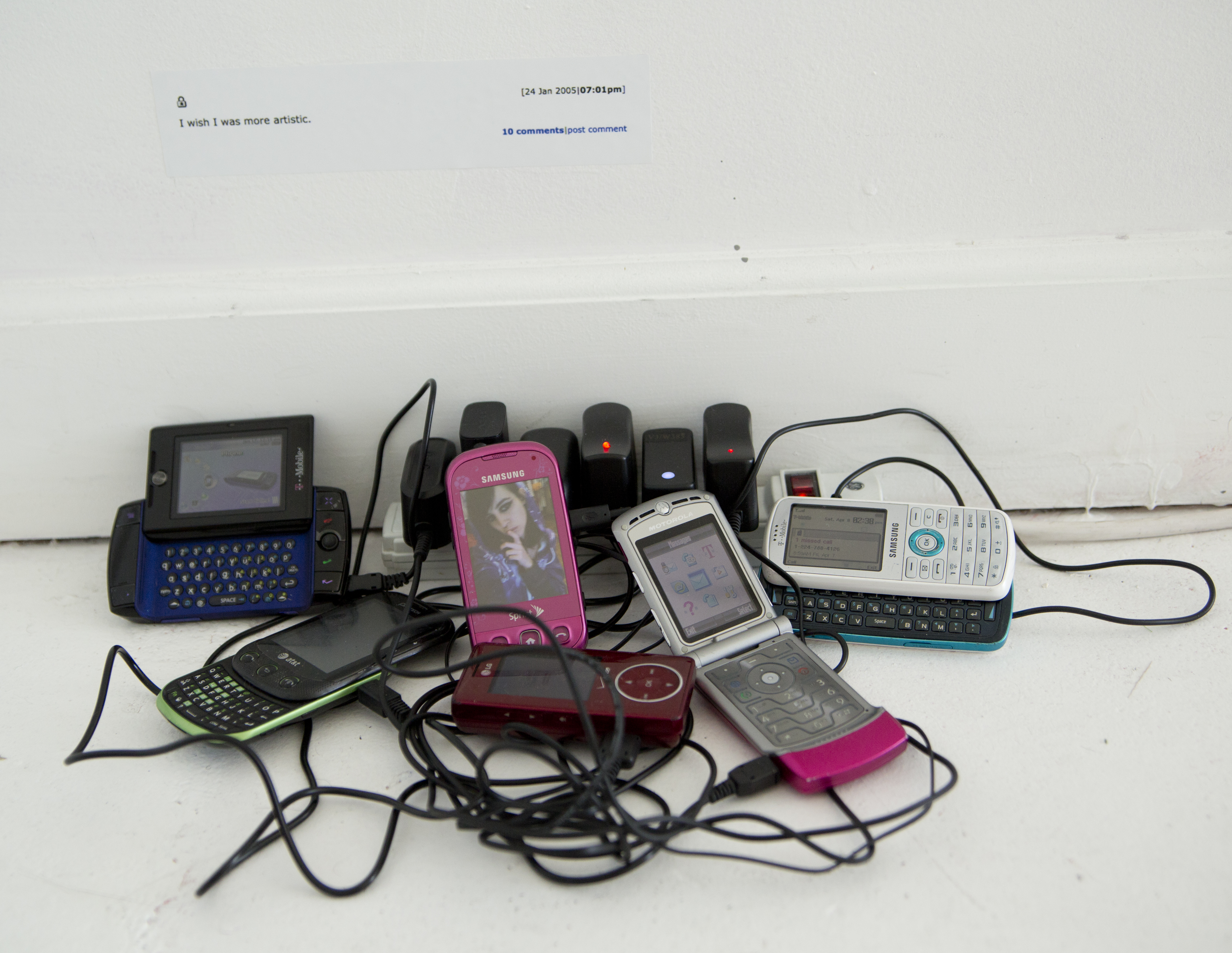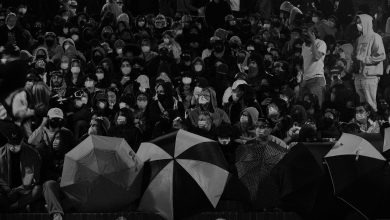From MySpace to Instagram: Talking Internet Evolution with Artist Molly Soda

Photo by Molly Soda
Do you remember what life was like before you had a smartphone? Maybe it doesn’t seem to matter because, like me, you were too busy being envious of your best friend who just got the pink Motorola RAZR flip-phone for her 12th birthday. But some people grew up online before the iPhone revolutionized the internet. New York-based digital artist Molly Soda has been documenting her life on the internet since she was 14 years old. In her latest work—her solo show “thanks for the add!” and her collaborative book “Pics or It Didn’t Happen: Images Banned from Instagram ”—Molly exposes the evolution of the internet into what it is today.
A few days ago, I sat in the heart of Chinatown in Los Angeles with one of my “favorite people I don’t know” before the opening of her show on April 6th at leiminspace. In her show, Molly pulls out her teenage internet archives from Myspace, AOL, and LiveJournal to create a discussion about the rapid growth of the internet.
“Maybe some people aren’t familiar with the same websites or tools that I’m using in the show, but it’s still nice to see a precursor to what you experience [online]… there’s just a lot of ties between all of it,” Molly explains.
It may have a cleaner, more advanced look, but the internet isn’t all that different from what it was ten years ago. Molly explains how Instagram and selfie culture are thought of as this “new thing,” but points out that she and many others have been participating in this “new thing” from a very early age. In fact, the first thing you see when you walk into “thanks for the add!” is two long tapestries hanging from the ceiling, printed with hundreds of selfies documenting the evolution of her internet persona over the years.
Pop-up ads also have a vital role in Molly’s show because their dominating internet presence has unshakable ties to the past. “You don’t really get a chaotic pop-up ad anymore unless you’re torrenting something or on a bad website… Everything now is embedded so that it feels natural,” Molly explains.
This illusion tricks us into believing that our online activity is a form of escape, when really our subconscious is picking up on the constant, invisible push of consumerism that is smartly blanketed by sites that distract us from reality with “organic” and “innocent” content for us to scroll through.
The lack of control we experience is something that Molly believes to have increased since she got online. She explains that the internet seemed like it “was sort of an ideal space of a utopia,” but now it is a constantly manipulated environment meant to make us feel safe, like we have a place to express ourselves, when really it is all an illusion that came to life as the internet became more and more corporate.
Molly elaborates, “Instagram could literally shut down tomorrow and no one would have any control over that. No one could get mad about it because it’s not your website. You’re not controlling that. That’s not yours, even though your profile feels very you.”
Likewise, we don’t seem to have much control over how we interact with the internet anymore because it has become so pervasive in our culture. Molly argues that the internet used to be “something that you opted into, and now it’s something that you’re obligated to in a lot of ways—like if you want to be successful as a creative person.”
Of course, the actual technology we buy to access the internet isn’t exempt from the influences of intense consumer culture. Just as we all seem to have smartphones now, the Motorola RAZR and the Samsung Sidekick were coveted just a few years ago. Both smartphones and these old phones are markers of status, but the latter is now shocking to see in anyone’s hand. Ultimately, these phones “were such big status symbols, and now they’re just meaningless.”
Molly’s solo show underlines the past to highlight the present. She is putting the utopian internet to rest and illuminating the subtle workings of the corporate influence.
“It’s interesting how these things get erased from our memories almost.” Pointing at her iPhone, she continues, “We’re like, ‘well I’ve just always had this. This is what I’ve always done, and I don’t know what you’re talking about.” Appropriately, Molly calls her show a “digital graveyard.”
But, of course, the internet isn’t inherently evil. “People use it for good and for evil. It’s just like anything else.” Over the past year, Molly and artist Arvida Byström have been using the internet for good—they created a “memorial” for images that have been taken off of Instagram for violating its “Community Guidelines”. This memorial comes in the form of a book called “Pics or It Didn’t Happen: Images Banned from Instagram.”
“We had both sort of noticed that a lot of people had been getting stuff taken down, and I’ve had stuff taken down, many artists I know have, and a lot of women I know have.”
Not only is the book filled with images that have been removed from Instagram, but the foreword is written by the renowned American author Chris Kraus. The two artists asked Kraus to write the foreword because of correlations between Kraus’ “I Love Dick” and their project.
“The book ‘I Love Dick’ was not super well received when it came out,” Molly reflects, “and now it’s had this resurgence because this generation is really relating to it. I find that the book itself, like Instagram and selfies and women’s art, is unaccepted or looked down upon, or it’s seen as lowbrow or superficial. I feel like her book was sort of seen that way, and now it’s garnered this attention, so [the two books] live nicely adjacent to each other in a way.”
The images submitted to Molly and Arvida are obviously all deemed unacceptable in some way, but the artists also found a trend in the types of bodies they received images of—white, cis, thin bodies.
“I think that certain bodies are told that they’re a little bit more passible. When I think about the way feminism has been branded online and who gets branded at the forefront of it—it’s always mildly deviant, hot white girls. So it’s the same idea like, ‘Oh, I feel a little edgy doing this, I feel good about doing this… but I’m not risking anything by doing it.’ Where I think that brown bodies or bigger bodies are often more sexualized and often also more demonized.”
The artists also learned a lot about how Instagram’s “Community Guidelines” work. After a photo is flagged on Instagram, “someone—usually a cheaply outsourced laborer—in India or in the Philippines makes the calls on these photos, and these are not the worst of the photos they’re seeing. They’re literally cleaning up the internet from beheadings and really graphic, violent imagery… We sort of just assume that robots are doing it or that it’s an algorithm, but it’s very human.”
And so what we’ve deemed “corporate internet,” which is pretty much just the entire internet, continues to invade with the censorship of bodies and the additional, unsurprising exploitation of workers.
“Pics or It Didn’t Happen” perfectly follows up “thanks for the add!” This book, along with Molly’s show, intend to reveal what we miss—what goes unseen. So what should we expect when we look through the book? We should expect to be pissed off.
“I’ll watch people look through [the book] and they’re like ‘Oh my god—why did this get taken down?’ There’s a lot of people being like ‘what the fuck?’. There’s a little bit of an outrage… I hopes it gives people a little more of an idea of how things are being policed.”
Molly’s solo show “thanks for the add!” is open until April 29th at leiminspace in Los Angeles. “Pics or It Didn’t Happen: Images Banned From Instagram” will be available in the US on April 27th, 2017.




